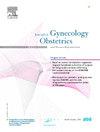爱婴医院倡议:区域执行情况、妇产单位和妇女特点的描述性分析。2021年法国全国围产期调查。
IF 1.6
4区 医学
Q3 OBSTETRICS & GYNECOLOGY
Journal of gynecology obstetrics and human reproduction
Pub Date : 2025-07-20
DOI:10.1016/j.jogoh.2025.102999
引用次数: 0
摘要
背景:爱婴医院倡议最初是为了促进母乳喂养而设立的,现已发展成为以新生儿及其家庭的需求为中心的更广泛的护理质量方法。在法国,从2010年到2024年,BFHI的采用率从2%增加到17%。然而,目前尚不清楚结构或人口特征是否会影响实施。目的:描述妇产单位的特点,妇女和新生儿在单位bfhi认证或在认证过程中,比较非认证。方法:数据来自2021年法国全国围产期调查,包括453个产科单位的10446名妊娠36至42周活产婴儿的妇女。双变量分析比较了三组:BFHIaccredited, in-process和non-accredited单位。结果:在产科单位中,12%获得bfhi认证,9%在进行中。区域实施差异很大(已认证的为0-44%,在制的为0-29%)。在产科单位的特点(规模、护理水平、行政状况、临时工作人员的使用)方面没有显著差异。在年龄、教育、就业和低风险怀孕方面,女性的概况相似。与非认证单位相比,高社会剥夺指数的妇女在认证单位和流程单位中的代表人数较少(4%和3%对5%),以及外国出生的妇女(14%和15%对22%)。结论:2021年在法国,法国实施的BFHI方案似乎与单位和妇女的结构、人口或健康特征无关。进一步的研究应探讨采用BFHI的动机及其对围产期护理实践的影响。本文章由计算机程序翻译,如有差异,请以英文原文为准。
Baby-friendly Hospital Initiative: descriptive analysis of regional implementation, maternity units and women characteristics. The 2021 French National Perinatal Survey
Background: Initially created to promote breastfeeding, the Baby-Friendly Hospital Initiative (BFHI) has evolved into a broader quality-of-care approach, centered on the needs of newborns and their families. In France, BFHI adoption increased from 2 % to 17 % of maternity units between 2010 and 2024. However, it remains unclear whether structural or population characteristics influence implementation. Objective: To describe the characteristics of maternity units, women and newborns in units BFHI-accredited or in-process of accreditation, compared to non-accredited. Methods: Data were extracted from the 2021 French National Perinatal Survey, including 10,446 women who gave birth to live infants between 36 and 42 weeks of gestation in 453 maternity units. Bivariate analyses compared three groups: BFHI-accredited, in-process, and non-accredited units. Results: Among maternity units, 12 % were BFHI-accredited and 9 % were in-process. Regional implementation varied widely (0–44 % for accredited and from 0–29 % for in-process). There were no significant differences regarding maternity units’ characteristics (size, level of care, administrative status, use of temporary staff). Women's profiles were similar in terms of age, education, employment, and low-risk pregnancy. Women with high social deprivation index were less represented in accredited and in-process units compared to non-accredited (4 % and 3 % vs. 5%), as well as foreign-born women (14 % and 15 % vs. 22%). Conclusion: In France in 2021, implementation of the BFHI program in France does not appear to be associated with structural, demographic or health characteristics of units and women. Further research should explore the motivations for adopting BFHI and its effects on perinatal care practices.
求助全文
通过发布文献求助,成功后即可免费获取论文全文。
去求助
来源期刊

Journal of gynecology obstetrics and human reproduction
Medicine-Obstetrics and Gynecology
CiteScore
3.70
自引率
5.30%
发文量
210
审稿时长
31 days
期刊介绍:
Formerly known as Journal de Gynécologie Obstétrique et Biologie de la Reproduction, Journal of Gynecology Obstetrics and Human Reproduction is the official Academic publication of the French College of Obstetricians and Gynecologists (Collège National des Gynécologues et Obstétriciens Français / CNGOF).
J Gynecol Obstet Hum Reprod publishes monthly, in English, research papers and techniques in the fields of Gynecology, Obstetrics, Neonatology and Human Reproduction: (guest) editorials, original articles, reviews, updates, technical notes, case reports, letters to the editor and guidelines.
Original works include clinical or laboratory investigations and clinical or equipment reports. Reviews include narrative reviews, systematic reviews and meta-analyses.
 求助内容:
求助内容: 应助结果提醒方式:
应助结果提醒方式:


